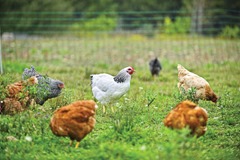Where now for poultry?
 eolas assesses the prospects for the sector as the EU labelling debate continues.
eolas assesses the prospects for the sector as the EU labelling debate continues.
Carton Brothers’ Managing Director Vincent Carton has told eolas that the Irish poultry sector continues to grow. But the man at the helm of the County Meath-based company went on to point out that it’s far from plain sailing for an industry that continues to compete head on with imported product.
“We need Brussels to finalise the new labelling regulations which will help local consumers to quickly and categorically identify Irish chicken in the shops,” he remarked. But this is a process that has been beset with delays. It was initially anticipated that the new regulations would come into force at the end of this year. However, this has now been pushed back to April 2015. At the heart of the issue is the debate now taking place between the European Parliament and the Commission.
“The Parliament has made it quite clear that it wants labelling regulations introduced for chicken that mirror those already in place for other meats.
“The response to this request from the Commission has been pretty lukewarm to date. My deep concern is that the delays in getting the new regulations past the post in Brussels will allow lobby groups with a vested interest in poultrymeat exports to secure a watering down of the current proposals.”
Under the regulations now envisaged, poultrymeat labels will give clear prominence to a specific product’s country of origin.
Vincent Carton again: “The new regulations should also ensure that the term ‘Irish chicken’ will refer explicitly to product that has been farmed and processed in Ireland. Under the proposed measures, there will also be a requirement for all retail outlets to label accurately the origin of the poultrymeat products they are selling.
“All of this is good news. And Farm Minister Coveney totally supports the labelling proposals, in their current form. But nothing can be done at national level until the European authorities enact the required legislation.”
Carton went on to confirm that white meat consumption continues to grow in Ireland.
“But competition with other meats is still a key factor in the marketplace. For example, Europe is oversupplied with pork at the present time. And the inevitable consequence of this unfolding scenario is that pork prices will fall. It’s all about supply and demand.”
He also believes that government must do more to clarify its intentions regarding the implementation of its Harvest 2020 strategy for those sectors other than beef and dairy.
Carton added: “Poultry has been grouped together with a number of other sectors including pigs, cereals, seafood, forestry and organic food production in the context of the Harvest 2020 report. The bottom line is that these sectors, combined, are expected to deliver an additional 15,000 new jobs.
“The poultry industry is prepared to do its bit in making all of this happen. However, it is incumbent on government to clarify what additional support measures it hopes to introduce in order to pump prime further investment within our industry.”
Vincent Carton went on to make the point that job creation within the poultrymeat industry is synonymous with additional growth in output.
He further explained: “It is more than feasible for processers to scale up their operations. And the same story holds true at farm level. In fact, most of our growers would welcome the opportunity to build a new shed, as it will allow them make more efficient use of the manpower and other facilities that are already on site. But government must play its part in making all of this happen.”
One of the most significant good news stories to have emanated from the poultrymeat industry over recent years has been the growing recognition that the litter left after the birds have been harvested is an excellent source of fertiliser.
Vincent Carton again: “Almost 50 per cent of the poultry litter produced in Ireland is utilised directly by the mushroom sector as a component of the growing medium required by that industry. However, I envisage a growing demand for litter from cereal and potato growers, who recognise its worth as a valuable fertiliser source. In reality, poultry litter is much more than a waste product.”





